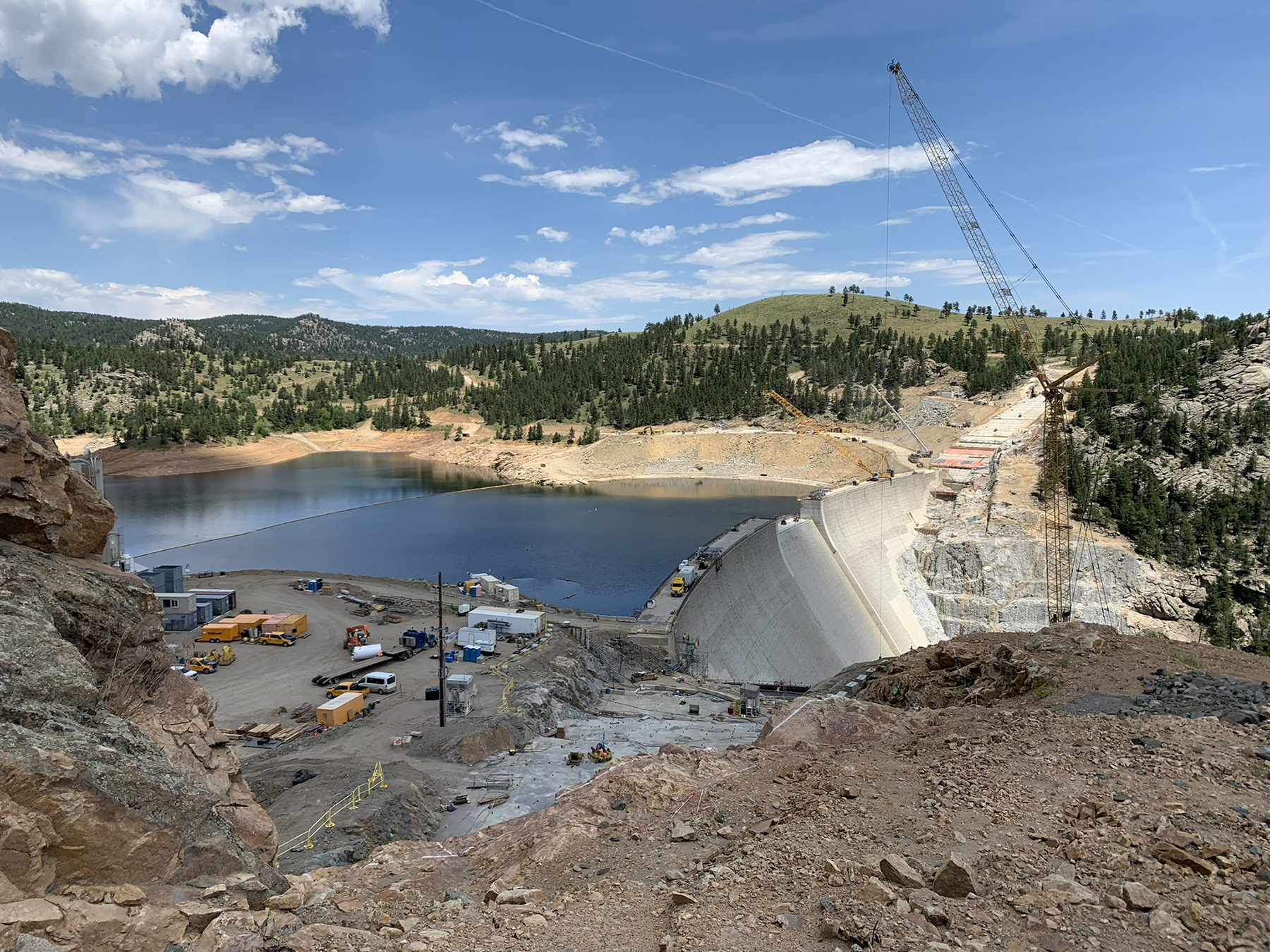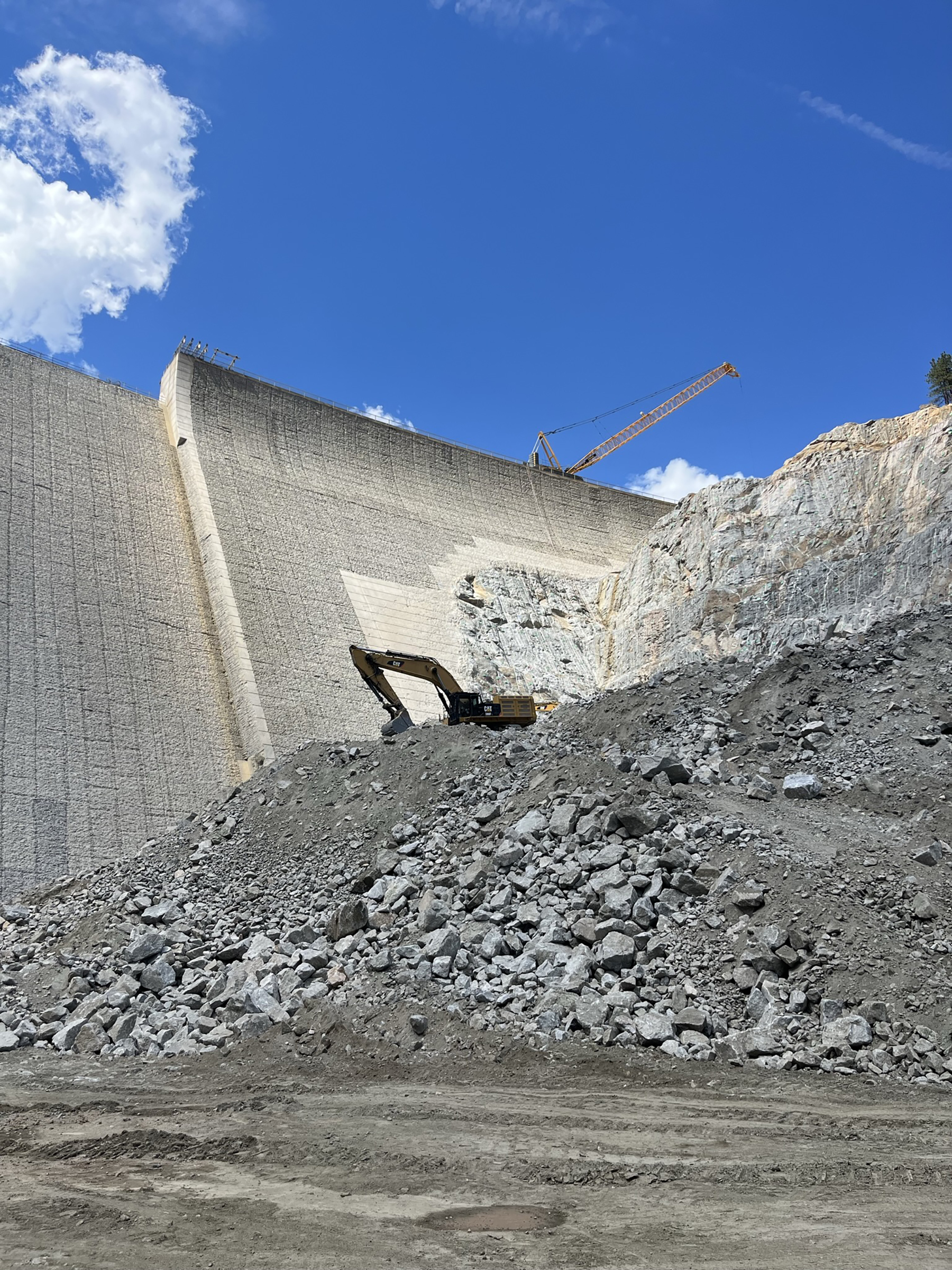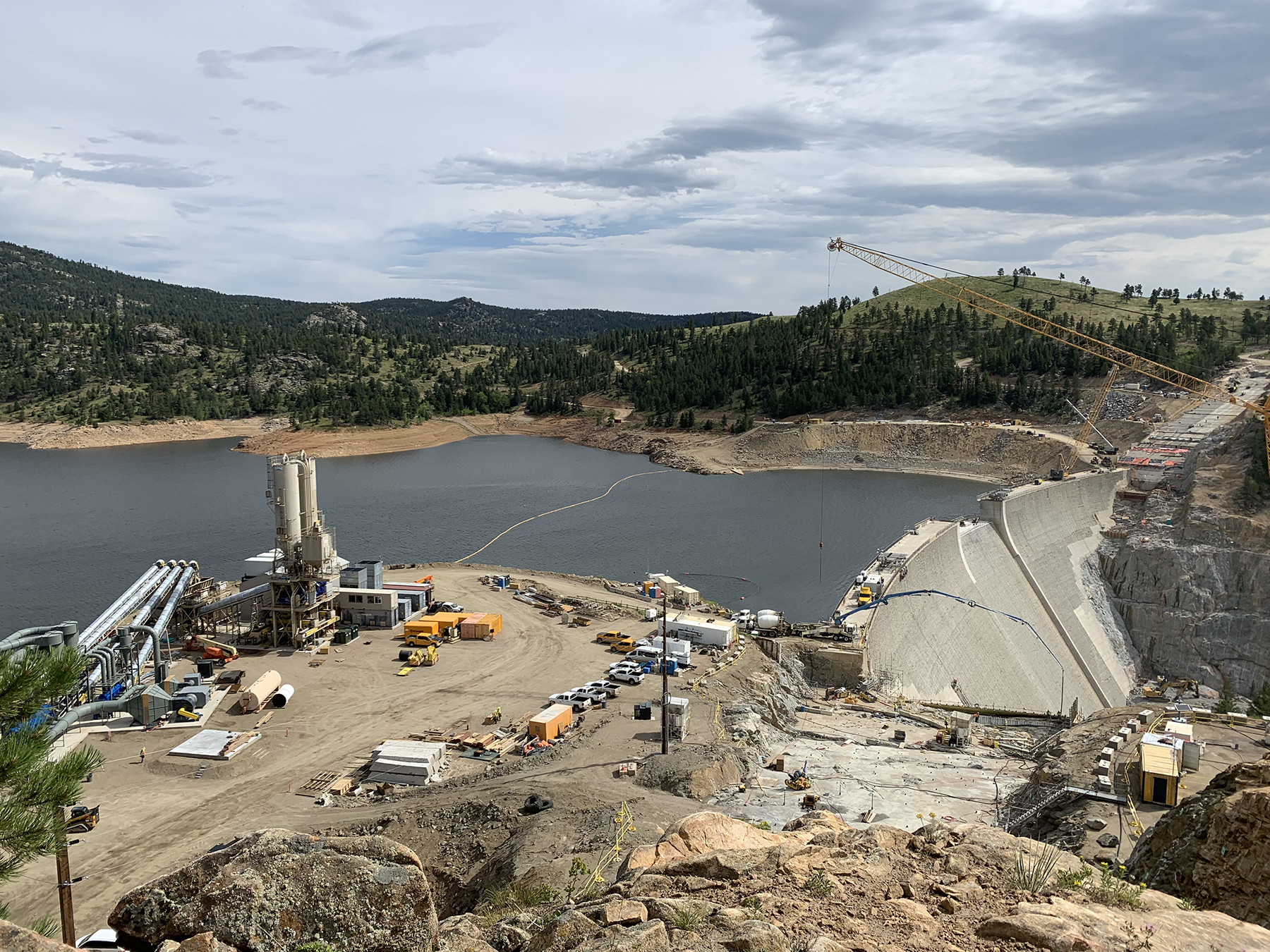By Jay Landers
After nearly two years of construction, Denver Water and its partners are set to begin this spring the crucial task of placing roller-compacted concrete along the downstream face of the 340 ft high Gross Reservoir Dam. The step marks the next phase in Denver Water’s ambitious effort to raise the height of the 70-year-old dam by almost 40% and nearly triple the storage capacity of the Gross Reservoir.
Key component
Situated on South Boulder Creek in Boulder County, Colorado, Gross Reservoir is a key component of Denver Water’s water supply system. As part of an effort begun by Denver Water in 2003, the utility is increasing the height of the concrete gravity dam that forms Gross Reservoir by 131 ft, raising it to 471 ft. At the same time, the project will lengthen the structure’s 1,050 ft long crest by approximately 890 ft.
As a result of these changes, the maximum storage volume of Gross Reservoir will swell from 41,811 to 119,000 acre-ft. The water body also will see its normal maximum surface area expand from 418 to 842 acres and its normal maximum elevation rise by 124 ft, from 7,282 to 7,406 ft above mean sea level.
Project construction began in April 2022, after Denver Water entered into a $564 million agreement with a joint venture comprising the Kiewit Corp. and the Barnard Construction Company Inc. The joint venture, which is serving as the project’s construction manager general contractor, has been involved with the project since 2019, when Denver Water awarded it a two-year planning and preconstruction contract.
‘Monumental effort’
As of late 2023, the contractor had completed a “monumental effort” to prepare the site and ready the existing foundation for the new dam, says Jeff Martin, P.E., Denver Water’s project manager for the Gross Reservoir expansion. “We had over a million yards of earthmoving that needed to happen on our site because we're in Colorado,” Martin says. “Colorado is vertical. It is all mountainous terrain, and there is not one flat area on this project to facilitate the construction of the dam.”
Several miles of roads had to be built or improved to enable truck access to the dam site as well as to the nearby quarry and on-site crusher that were created to provide aggregate for the project. A concrete batch plant also was constructed as part of the project’s first phase.
As for work performed on the existing dam, construction crews removed the crest of the overflow spillway to facilitate future RCC placement, says Felipe Garcia, P.E., the resident design engineer for Stantec. The engineering consulting firm served as the design engineer during the design phase of the project before transitioning to the role of engineer of record for the construction phase. AECOM has served as a major subconsultant to Stantec, while Black & Veatch has served as the program manager and construction manager.

Because of its curvilinear shape, the existing ogee spillway “would produce unwanted stress concentrations in the raised dam,” Garcia says. “The stresses would distribute a lot more smoothly if we had a flat area,” he says. For this reason, the top 13 ft of the crest was removed to make the top of the spillway “completely flat,” Garcia says. In this way, stresses from the raised dam will be transferred to the existing dam “more uniformly and more smoothly,” he notes.
As part of additional work done to the existing dam, the project team had to ensure that the dam’s face would bond adequately with the RCC used for the dam raise. To this end, construction crews used a technique known as hydrodemolition to remove “between 2 and 3 in. of concrete from the downstream face of the dam,” Garcia says. The technique sprays water under extremely high pressures against the dam face to remove weathered concrete, leaving roughened, competent concrete in place to provide a better bond for the RCC.

Preparing the foundation
Much of the construction effort to date has focused on preparing the foundation of the existing dam, a task complicated by the rugged terrain of the canyon in which the dam is situated. “We're literally working on the side of two 500 ft cliffs,” Martin says.
These preparations have included blasting and excavating more than 250,000 cu yd of rock that was deemed unsuitable for the foundation of the raised dam. “That's a big amount under any normal circumstances,” Martin says.
Following excavation, the resulting natural rock surface contained many “sharp curves and corners” and other irregularities that could lead to stress cracking following RCC placement, Martin says. Dental concrete and foundation concrete were used to fill in and level out these locations. “That's prepared a really nice surface for the new dam construction and new dam raise,” Martin says.
To prevent settlement following RCC placement, consolidation grouting was pumped up to 30 ft below the foundation. A grout curtain then was installed up to 200 ft beneath the dam to reduce permeability and prevent seepage. “That puts us in a position to then raise the dam on top of that prepared foundation in 2024,” Martin says.
Given its location in a low valley, the dam lacks the natural topography needed to provide abutments for the upper portions of the new, larger structure. Overcoming this limitation requires designing and constructing artificial abutments, known as tangential thrust blocks, to provide the necessary support. “We decided to design the (dam) raise with two thrust blocks at each abutment,” Garcia says.
This “very unique and interesting” aspect of the project, Garcia says, essentially will convert the dam from a gravity dam to a thick-arch structure, or one that relies on its weight as well as its abutments for stability. Although the existing dam is curved in plan view, “the original design really didn't account for the additional stability that the arch provides in the structure,” he notes. “We're actually transforming the structural behavior of the existing dam.”
Heat control is crucial
In concrete dam construction, the “No. 1 success factor is controlling the heat of the concrete” that results from the combination of water and cement, Martin says. If not controlled properly, this so-called heat of hydration can lead to tensile stresses and cracking as the concrete first expands and then cools.
A key part of the design phase entailed determining how to control the heat of the RCC following its placement during the dam raise. “We decided that in order to obtain the behavior that we wanted from the raised dam, the RCC needed to be placed at 50 degrees Fahrenheit” or lower, Garcia says. However, achieving such low concrete temperatures was expected to prove “challenging,” he notes.
To accomplish this critical goal, the Kiewit-Barnard team designed and constructed the “most state-of-the-art concrete batch plant that's ever been built,” Martin says. As a first step in the production of cold RCC, the contractor continuously wets the coarse aggregate with chilled water as it leaves the crushing plant and enters the batch facility. Before it is mixed with the aggregate, sand “gets suspended in air-conditioned cold air” to lower its temperature, Martin says. Finally, up to 80% of the water that normally would be used in the production of the concrete is replaced with ice.
“It’s one of the first projects of its kind (in which) the batch plant itself has been designed and tuned to the design of the dam to ensure that we place the right temperature concrete to control the temperature gain in the dam,” Martin says. “The batch plant itself is an engineering marvel.”

As a test run of sorts, the project team placed 5,000 cu yd of RCC as part of a “full-scale trial placement” in October, Martin says. The trial was done “to prove that our processes and our quality of our materials and our management was going to succeed when we actually started raising the dam,” he says.
During the trial, the batch facility produced RCC that was 37 F or lower, Garcia says. “I was thrilled,” he says. “If we're able to produce RCC at 37 degrees, we’ll be able to produce RCC at 45 degrees, so we can place it at 50 degrees. That was a great project win, in my opinion.”
Looking ahead
RCC placement is scheduled for 2024 and 2025. “We're going to place about half the dam in each year,” Martin says. In both years, the work will begin in May and proceed through November or December, weather permitting. With the project at an elevation of nearly 8,000 ft, “weather is a big challenge here,” Martin says.
Against this backdrop, RCC placement will occur continuously while conditions allow it, Martin says. “Our goal is to almost never stop.”
This article is published by Civil Engineering Online.



